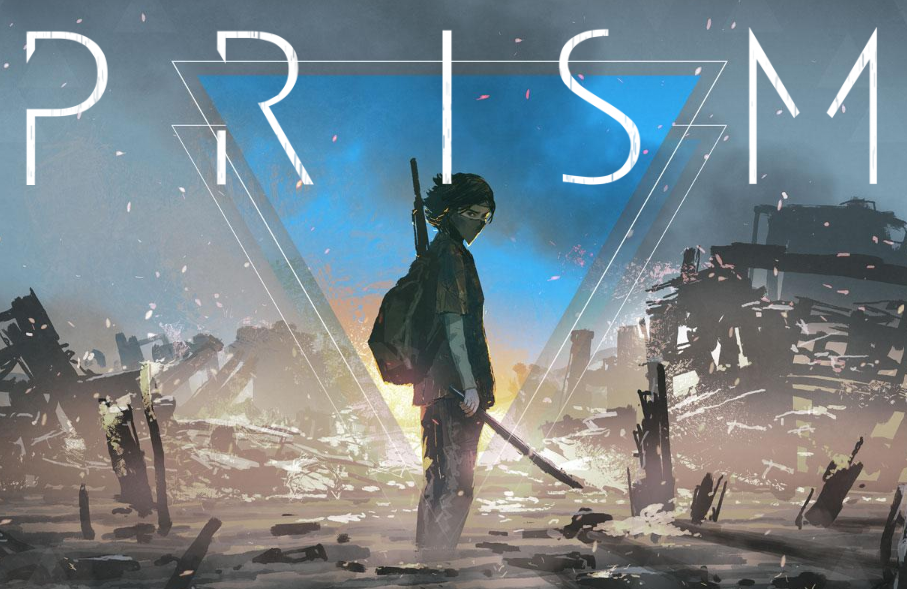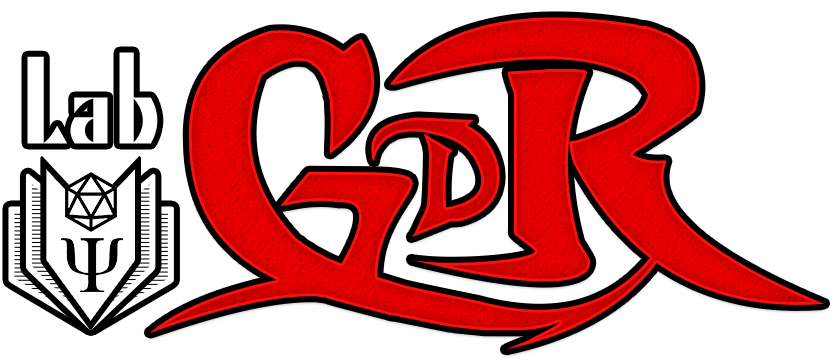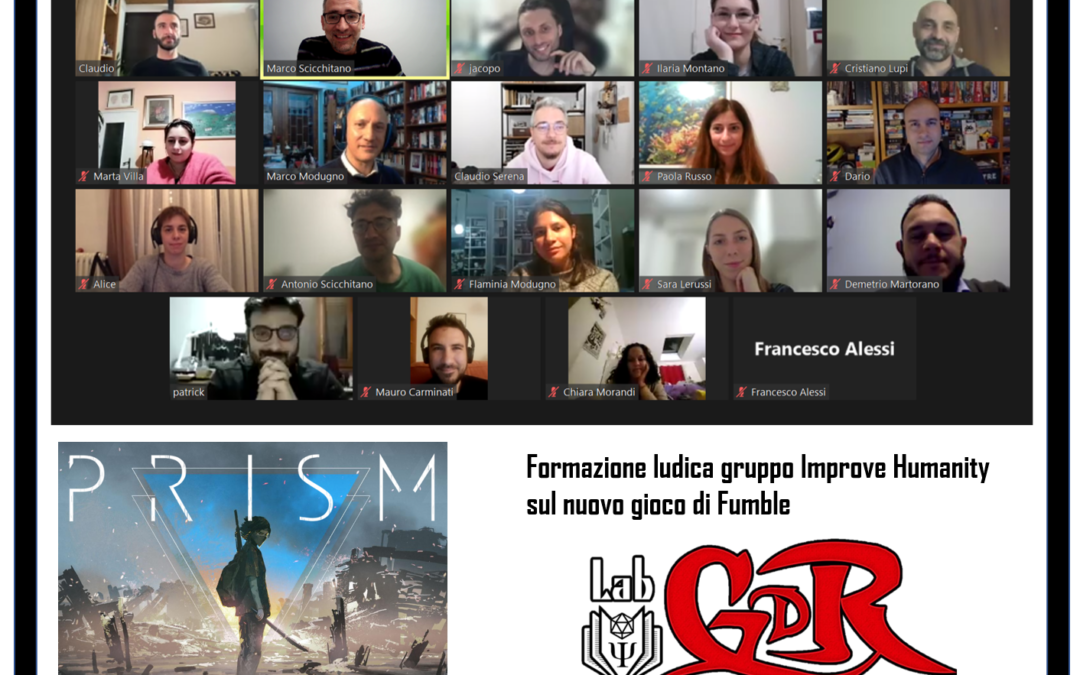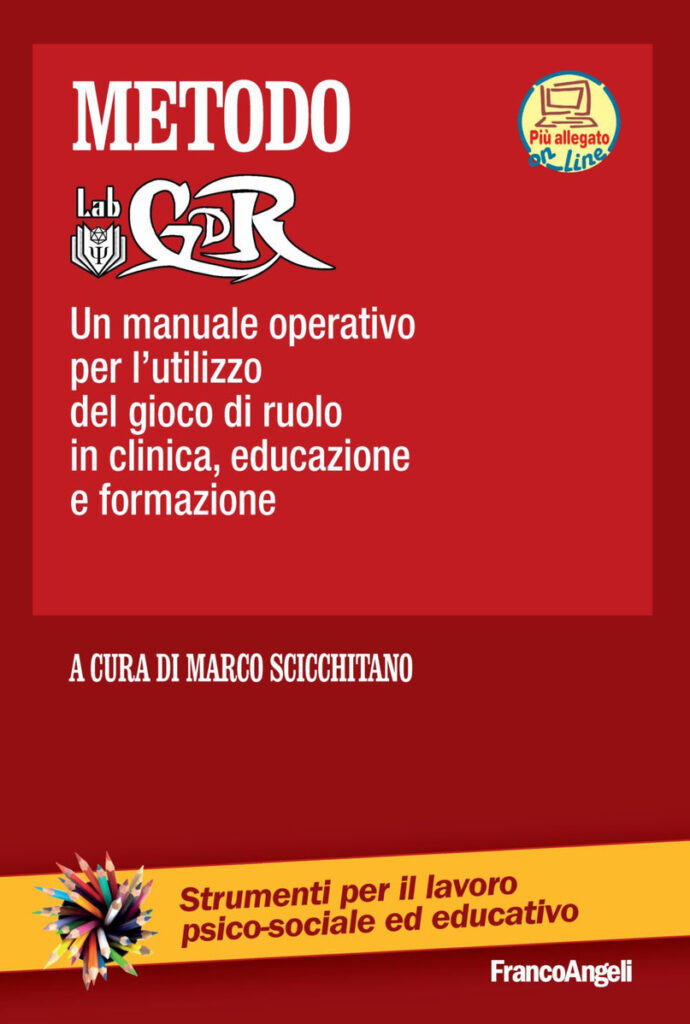CONSIDERATIONS ON PRISM, tabletop role-playing game by Claudio Pustorino published by Fumble
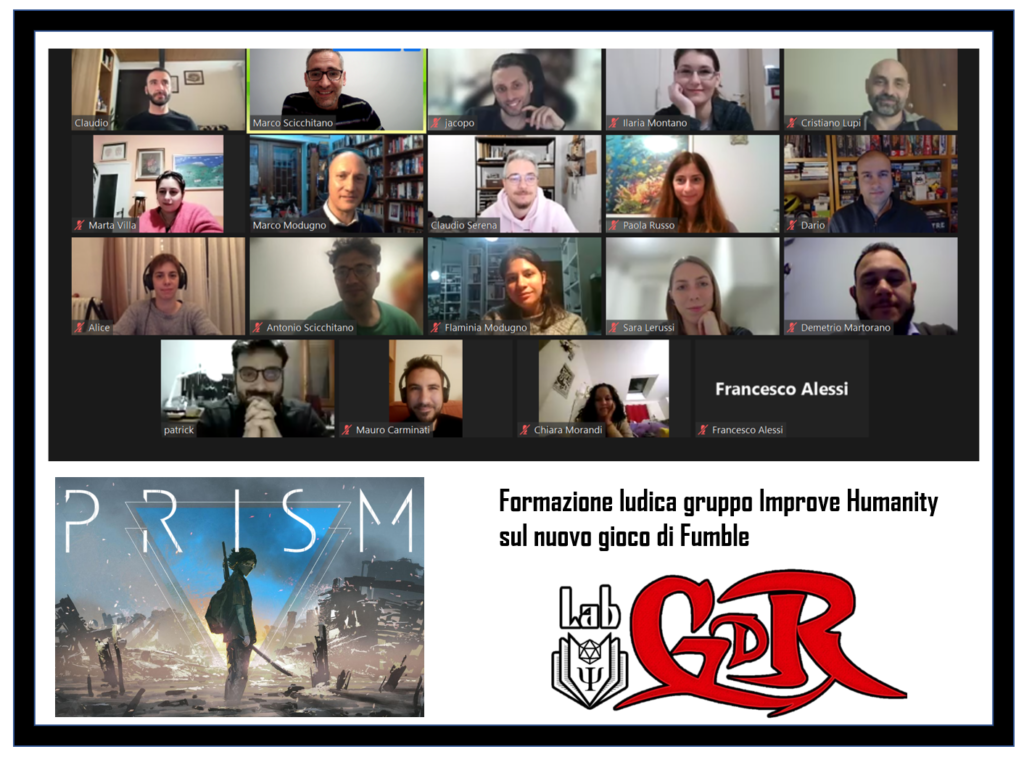
The Company of LabGDR operators meets periodically to continue to see each other, have fun and train together, and it also does so by playing 😊
We alternate theoretical-applicative trainings, with playful trainings, in which we experiment with new or already known games, to evaluate together their applicability in the LabGDRs that we carry on now in different parts of Italy.
After last year’s training with #NotTheEnd, by which we were very impressed, so much so that we are already using it in several projects, we took the opportunity to try out #PRISM, a forthcoming GdR published by @Fumble. We had the luck and honor to play it directly with the masters of Fumble including Claudio Pustorino, author of the game. With him were present as masters Alice Luidelli and Claudio Serena.
The evening was structured with a brief introduction of the participants: 3 game tables into which the 18 LabGDR operators were divided, 12 players and 6 “observers” divided in pairs in the 3 tables to actively observe the game processes, the play dynamics, the possible outcomes to be used in psychoeducational workshops. At the end of the game session, we collected ideas in a plenary debriefing, and in this document we summarize the impressions of the working group. The evening had a precise methodology that we intend to replicate with other games in the future, so as to progressively build a specialized library of LabGDR reviews to the games we will try over time, evaluating them from the different points of view that make up the Company of LabGDR operators, sifting through their possible applications in laboratory settings. Taking things seriously is the way we like to play.
PRISM is a game centered on a literary “genre,” a creative theme, from which it draws the narrative setting, the characterization of the characters, and the evolutionary modes of the character whose fundamental aspects the player can create in a matter of minutes, composing in-game the imaginary representation of the character he or she has in mind to play, through a simple narrative composable system of descriptive labels. As explained to us by the author, a literary genre can be nuclear and germane to a central human emotion or experience, to be placed at the center of the creative prism of the setting as much as of the character and game dynamics.
The genre we played is the dystopian genre, where what creates game situations and setting are the evocations of the emotion of FEAR. The characters live, in fact, in an oppressed and dangerous society, where personal specificities are undone as they are molded and massified, sacrificed to the demands of dystopia. Only a few divergent individuals misalign from the imposed authoritarian imperatives, and such individuals are called ANOMALITIES. Players will lead, accompanied by a master, their characters through the cramped streets and tunnels of cities plagued by tyrants or oppressive laws or systems, bringing, by their very existence as anomalies, a powerful reagent that will trigger narrative stimuli and dangerous situations that must be addressed through the mechanics of TURNING POINTS, in which character traits, fear and adversity will mingle together and then reassemble into coherent and organic outcomes through the shared narrative of the players and the master.
Some general considerations about possible uses of the game in a workshop setting:
- Merely characterizing the characters as ANOMALIES in relation to a strong and coercive societal system immediately sets the players up to experience the group with an inclination toward internal cohesion and solidarity. This dynamic we believe can be useful in the creation of workshop groups.
- The methodological choice of the game to “evoke” action with key questions [What do you desire? What is your goal? How much fear do you feel?] allows the emergence of individual drives oriented toward change in a personal way, from intrinsic determinations. These motivations can be the subject of reflection or consideration with the support of the practitioner and be concretized into s.m.a.r.t. goals.
- Continuous exploration of the same state, which in the case of DYSTOPIA is FEAR with the question “How afraid are you?” calls into question continuous monitoring. The answers to this question and the investigation of the reason for these answers can provide useful clues about a person’s emotional coping abilities. Imagine, for example, cases of anxious states (not fear proper). Indeed, anxiety symptomatology often includes hyperfocus on body/mental states and selective attention limited to certain aspects of the context. Due to the mechanics of the game, the presence of more “objective” attention to contextual elements that may refute the initial dysfunctional premise, and less marked severity attributed to internal events, might lead to indicate a lower level of anxiety. Experiencing a fearful/anxious emotional situation in a simulative environment allows one to experience the emotion, talk about it, describe it, relate it to the activating factors, assess its dysfunctional behavioral outcomes, and through all these processes could improve its management through ludiform exposure and reflection in a Meta 2 moment.
- When a TURNING POINT is proposed, players are asked if they have a purpose or goal to achieve in that particular situation. Such an approach is very useful for stimulating in players various mental skills such as context reading, personal motivation, social or practical problem solving skills, and, more generally but not least, taking an active and personalized posture toward a crisis situation.
- The outcomes of a POINT OF DEVELOPMENT test can of course be different from what is desired/planned, requiring one to re-narrate what actually happened. This outcome, due to the random components inherent in this as in so many role-playing games, is perfectly compatible with the idea that desired change is not linear at all, and can be used intentionally to help a person accept the normal fluctuations of a change process and to support ongoing re-narration of what is happening in life.
- At the end of managing a TURNING POINT, players can transform the fear into a new trait. If this dynamic is well managed and preceded by an accurate description that encourages identification, it is possible to be able to exorcise fear by integrating it into the traits of the Anomalies, e.g., the choice of trait after passing the moment of trial can be made by thinking precisely of the difficulty just faced, thus integrating the constituent traits of the Anomaly with a trait “gained” from the experience just lived. This process can be considered a very effective symbolization of what happens in real life and very useful from a therapeutic point of view.
- Through the acquisition of new traits as a result of the TURNING POINTS, it is possible to have in the form the possibility of longitudinally reconstructing the path taken by the Anomaly. This, therapeutically speaking, can be an important element in the gradual acquisition of self-awareness, stimulating self-reflexivity and metacognition through a process of monitoring and integration.
- Another interesting element is the reflection regarding the fate of an Anomaly: differentiating oneself (taking on more and more “abnormal” traits) or conforming to Dystopia (taking on related traits or losing one’s own); this issue can also be a relevant topic to be addressed in a therapeutic context, in a path aimed at a differentiation of the individual, particularly relevant for young adults or those with entangled personalities. In a LabGDR one could, for example, reflect on this element through targeted questions and circle time in Meta2 moment focused on understanding the feelings experienced at the time of choosing the new conforming or divergent characteristic.
- The game lends itself to stimulating imaginative and context-reading skills: we find it very stimulating to be able, at the turning point, to give an explanation and explication of what is happening in the here and now, at the level of context and experiential experiences (related to Anomaly’s background and traits), as well as emotions felt in the moment (with Anomaly’s description of the intensity of fear, in response to the description of danger given by Dystopia).
- The dynamics of the DEVELOPMENT PUT and descriptive labels, leads to reflections onidentity in a coherent and evolutionary way, even with immersion in tight shoes, which may wear out and get dirty in the impact with uncomfortable situations in which we would never want to get involved. It is precisely in these circumstances that the character will find, for better or worse, fertile ground for growth and transformation: they embody a load of novelty that forces the player to renew himself and make choices that, in everyday life, he would deem impossible given his idea of himself. What we think we know is challenged by what we have never faced: the player’s evolution can thus be parallel to that of the character, since through the latter he or she has a way to explore parts of his or her own identity, discover something new about himself or herself, and learn from his or her experiences: it is by facing fear that PRISM players can know-and increase-the measure of their courage
- In one playgroup, there was little room to observe game dynamics in situations involving comparisons between two or more Anomalies. The result was the repetition of situations of comparison between Dystopia and a single Anomaly, with similar patterns (despite different scenarios dictated by the single turning point) and almost automatic mechanics. We recommend to a LabGDR operator that he or she anticipate situations activating the motivations of more than one character, so that the question “who wants to enter this TURNING POINT?” is prompting more than one player to imagine what his or her involvement might be. Care should be taken to avoid presenting situations involving only one player too often, as the game may be unengaging for participants not directly involved in the TURNING POINT, especially with large numbers of players. We also believe that interactions between one or more Anomalies may leave room for elements of less predictability and bring out unexpected traits, as well as may bring to light-in the view of goal achievement-dynamics of collaboration/participation, competition or confrontation that, addressed in possible turning points, could lead to interesting evolutions of the Anomalies; increasing the levels of complexity of the game with multiple relational dynamics would certainly make it more interesting and fun.
- Particularly interesting is the possibility that a personal goal for which one has decided to enter a TURNING POINT may not in fact be pursuable in the overlapping interwoven narrative levels created by the motivations of the individual players participating, each with their own purpose, in the same TURNING POINT, causing players to find themselves using their own actions and characteristics for dynamics they had not imagined. Fertile dynamics for postgame reflections in a Meta2 moment.
Directly relating the game to the LabGDR Method, (The LabGDR Method fosters the learning of new metacognitive, emotional and relational skills, using the tool of live and tabletop role-playing games, through the use of simulation, interaction dynamics and play, intentionally oriented toward the pursuit of meaningful goals chosen taking into account the scope of intervention, the characteristics of the participants and the desired outcomes), we can say that Prism is a game suitable for achieving psychoeducational goals, with due caution.
- Learning areas: play used with due preparation can greatly stimulate metacognitive skills, particularly: differentiation, monitoring, mastery. It allows working on relationships, helping to decentralize during the unfolding of TURNING POINTS. Having a clear focus on the emotion of fear, it is a great tool for specific workshops on emotional management.
- Processes used: the game helps create a coherent simulative environment by trying to create organicity between the emotional color that characterizes the characters’ experiences and the setting. The “literary genre” coherence helps support the imaginative scaffolding that allows for better simulative immersion capable of intercepting not only the fantasy in terms of description but also the emotional, distressing and dangerous experience. Interactions are used in shared storytelling between master facilitator and players, as well as in dynamics where multiple anomalies are involved. The playful experience is emotionally engaging as it activates experiences of alertness and danger and numerous scenarios where it will be important to activate social problem solving.
- Aims: We believe that PRISM may be suitable for psychoeducational workshops with adolescents only after assessment of tolerability by the referring clinician. Young adults and adults is the ideal target audience based on age, although the dystopian genre and the theme of differentiation vs detection through evolution of abnormality are very important themes in adolescence. PRISM can be a great tool for a specific workshop with goals focused on improving the emotion of fear. It could be very useful to precede the game with group sessions in which psychoeducation is done and behavioral worksheets on fear management such as those provided in DBT manuals are administered.
After this first trial, for us the ideal application from a LabGDR point of view a psychoeducational workshop for adolescents or young adults, focused on emotional management, literacy and social problem solving, or, with participants diagnosed with phobic disorders who can use play to increase imaginative exposure to feared events and management skills through the use of the metacognitive skills of differentiation, monitoring and mastery. In this second mode, it is necessary to have an experienced clinician on the team.
We greatly appreciated that fear, from being simply a smoky ancestral emotion that elicits behavioral blockade and cognitive distancing, can become both a creative engine and an element of narrative stimulus, can be described and evaluated, considered in its intensity, observed in others, experienced in groups, and made a factor in each character’s possible evolutionary learning. As might be the case with an obscure and unexplored mass, placed in a particular lens from different observational points that through each surface allows a filter to be applied that reveals its colored, three-dimensional and shaped characteristics because of different observable spectra.
A PRISM Lens
By: Company of LabGDR Operators
